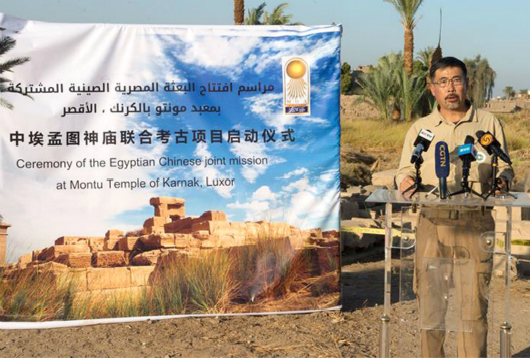
. > TOP STORIES
Experts review China’s archaeology over 40 years
Author : Zeng Jiang Source : Chinese Social Sciences Today 2019-02-01

Jia Xiaobing, head of the Chinese archaeological mission in Egypt, addresses the launching ceremony of a joint Egyptian-Chinese archaeological mission at Montu Temple in Luxor, Egypt, on Nov. 29, 2018. Photo: Meng Tao/XINHUA
Chinese archaeology has achieved remarkable development in its research approaches and results since the reform and opening up.
Wang Wei, a Member of the Chinese Academy of Social Sciences and head of the Society of Chinese Archaeology, said that the achievements of archaeology since the reform and opening up can be summarized as follows: Archaeological institutions have been established one after another, and archaeological excavations carried out along with construction projects have served as the backbone. Archaeological work has blossomed everywhere, and the number of excavations has increased. More archaeological discoveries have been emerging, and important achievements have attracted worldwide attention. International exchanges and cooperation have been increasing and fruitful. And research methods have become increasingly diverse, facilitating an information explosion.
With the social and economic development over the past four decades, the annual number of archaeological investigations and excavation projects implemented nationwide has grown from just one hundred to two hundred in the early 1980s to thousands in recent years. Super-large engineering projects such as the Three Gorges Dam Project and the South-to-North Water Diversion Project mobilized national archaeological excavations alongside them. Participating units numbered as many as sixty to seventy, which can be regarded as the world’s largest archaeological project ever carried out along with a construction project.
Lin Xiang, a professor from Sichuan University, said that since the reform and opening up, the excavation and protection of large-scale relics in the country has progressed smoothly, and many important discoveries have emerged. Archaeological theories continue to be innovative, from the science and technology of archaeological research to environmental archaeology.
Sun Zhouyong, president of the Shaanxi Provincial Institute of Archaeology, said that over the past 40 years, the research objects and disciplinary objectives of Chinese archaeology have undergone major changes. Field archaeology based on multi-disciplinary joint research has seen ever-enhanced scientific and technological means. Archaeologists have mastered unprecedentedly broad and deep knowledge of cultural relics and promoted archaeological research to shift its focus from material culture history to social history.
Along with the innovation of archaeological concepts, numerous outstanding research results have emerged. Shaanxi Province can be described as representing the epitome of the development of Chinese archaeology. Since 1978, Shaanxi has witnessed a major archaeological discovery almost every decade. Such discoveries as ancient humans, prehistoric settlements, imperial tombs and ancient capitals have been significant for understanding the excellent ancient civilizations of Shaanxi and even China, making significant contributions to Shaanxi’s economic and social development.
Chinese archaeology has initially formed theories and methods with Chinese characteristics in the four decades of the reform and opening up, said Zhao Binfu, dean of the School of Archaeology at Jilin University. From geological stratigraphy to archaeological stratigraphy, from biomorphology to archaeological typology, archaeology has been exploring approaches in practice. The application of natural science and technology in archaeology and the application of the results, methods and materials of the humanities and social sciences have enriched the meaning of archaeology itself and changed its appearance.
Wang said that since the reform and opening up, various foreign theories and research methods have been introduced to China, which has greatly promoted the development of Chinese archaeology. The Chinese archaeological community has carried out various forms of exchanges with the international academic community, conducting hundreds of cooperative investigations and excavations in China.
In the past decade or so, with China’s enhanced national strength, an increasing number of Chinese archaeological teams have gone abroad to explore the sites of other primitive civilizations in the world in neighboring countries and even Egypt and Central America. The international influence of Chinese archaeology is growing, Wang said.
At the end of 2018, the first China-Egypt joint archaeological project was launched at the site of the Temple of Montu in Luxor, Egypt. This is the first time that a Chinese archaeological team has been sent to Egypt for excavation since the founding of the People’s Republic of China in 1949.
Ye Shengtao made Chinese fairy tales from a wilderness
Ye Shengtao (1894–1988) created the first collection of fairy tales in the history of Chinese children’s literature...
-
How northern ethnicities integrated into Chinese nation
2023-09-18
-
Mogao caves
2023-09-12
-
Mogao Grottoes as ‘a place of pilgrimage’
2023-09-12
-
Time-honored architectural traditions in China
2023-08-29
-
Disentangling the civilizational evolution of China
2023-08-28
-
AI ethics in science fiction
2023-08-23













 2011-2013 by www.cssn.cn. All Rights Reserved
2011-2013 by www.cssn.cn. All Rights Reserved